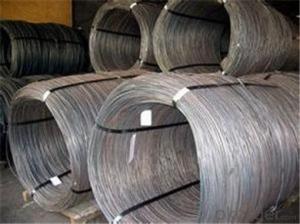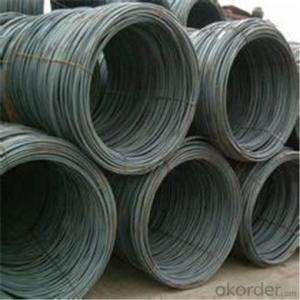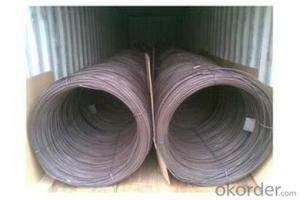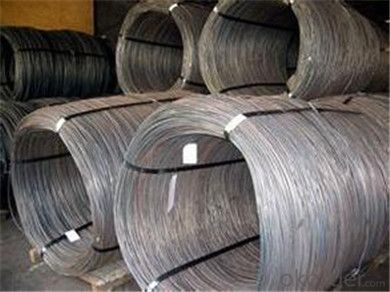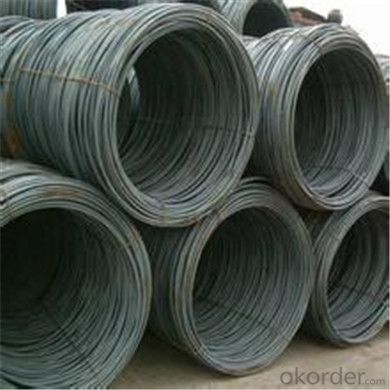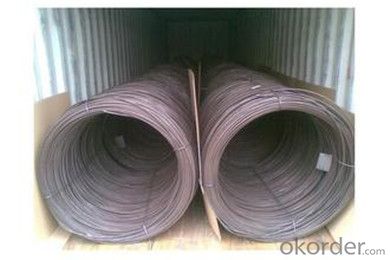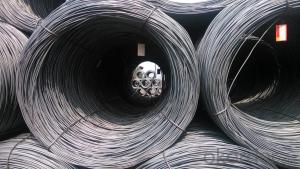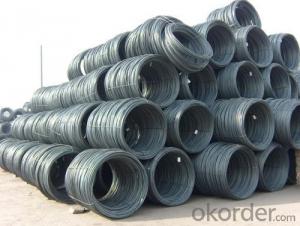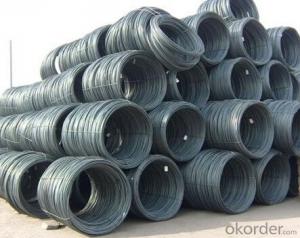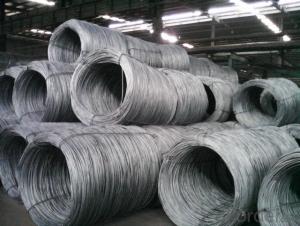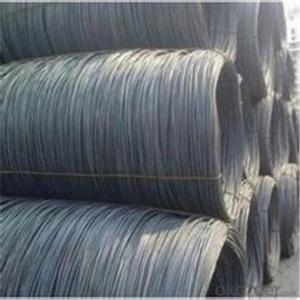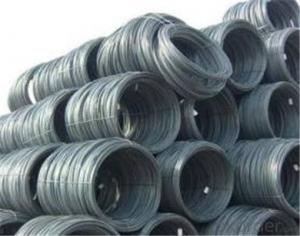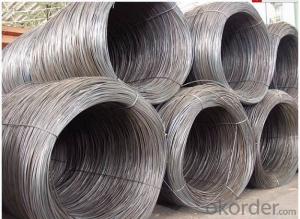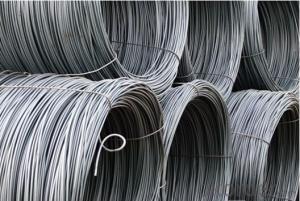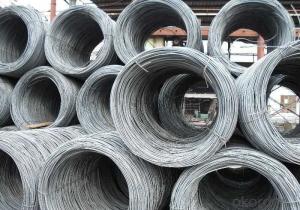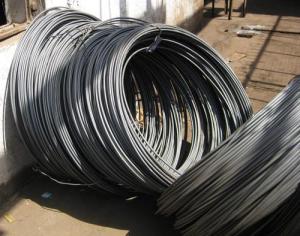SAE1008Gr Steel Wire rod 6.5mm with Best Quality
- Loading Port:
- Shanghai
- Payment Terms:
- TT OR LC
- Min Order Qty:
- 99 m.t.
- Supply Capability:
- 45555555 m.t./month
OKorder Service Pledge
OKorder Financial Service
You Might Also Like
Specification
Description of wire Rod:
wire rod:
Grade:SAE1006B/SAE1008B/SAE1018B
Size:5.5/6.5/7/8/9/10/11/12mm
Festures of wire Rod:
· Umbrella ribs, upholstery wires, cycle spokes, needle wires, heald wires, staple pin Wire, safety pin wires
· ACSR wires, earth wires,
· tyre and hose reinforcement wires
· prestressed concrete wire, springs and rope wires,
· card clothing wires,
· vineyard wires,
Specifications of wire Rod:
Grade | Chemical Composition(%) | |||||
C | Mn | Si | S | P | Cr | |
SAE1008B | 0.10max | 0.3~O.50 | 0.15max | 0.050max | 0.040 max | 0.3-0.35 |
Mechanical properties | ||||||
Yield strength(N/mm2) | Tensile strength(N/mm2) | Elongation(%) | ||||
≥195 | 315-430 | ≥30 | ||||
| Packaging Details: | (1) Coils are wrapped by 8 steel strips; (2) Wrapped by waterproof cloth; (3) Wrapped by 8 steel strips (6+2) ; (4) Added with wood pallet |
Images of wire Rod:
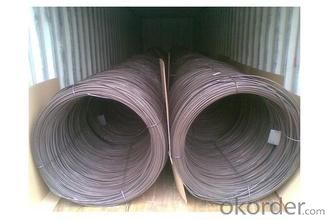
FAQ:
1. What is your package?
Packing situation: standard seaworthy packing or as customer required.
2. How long is the lead time?
Delivery time: 45 days after order confirmed.
3. What payment term do you accept?
Payment: T/T or L/C at sight.
- Q: How does the magnetic properties of steel wire rod vary with different heat treatment processes?
- The magnetic properties of steel wire rod can vary significantly with different heat treatment processes. Heat treatment processes such as annealing, quenching, and tempering can influence the microstructure and crystallographic orientation of the steel, which in turn affects its magnetic properties. For example, annealing can result in the formation of a soft magnetic structure with improved magnetic permeability, while quenching and tempering can produce a harder magnetic structure with higher coercivity. Overall, the specific heat treatment process employed can determine the magnetic properties of steel wire rod, making it possible to tailor its magnetic characteristics for specific applications.
- Q: How is steel wire rod used in the manufacturing of wire forms for automotive seat belts?
- The manufacturing process of wire forms for automotive seat belts relies heavily on steel wire rod. Utilizing advanced machinery and techniques, the wire rod is initially processed and shaped into the required form. This form serves as the foundation for the intricate design and structure of the seat belt, guaranteeing its durability and strength. Steel wire rod is specifically chosen for this purpose due to its exceptional strength and high tensile properties. It possesses the necessary resilience and flexibility to withstand the stresses and forces encountered by seat belts during everyday use and potential accidents. To further enhance their performance characteristics, the wire forms undergo additional processing and treatment. This may involve various methods such as heat treatment, galvanization, or coating processes to improve their resistance against corrosion, wear, and tear. The wire forms are then assembled alongside other components like buckles and retractors, completing the seat belt assembly. The strength and quality of the steel wire rod used significantly contribute to the overall safety and reliability of the seat belt system. In summary, the crucial manufacturing process of wire forms for automotive seat belts heavily relies on steel wire rod. This material provides the necessary strength, durability, and flexibility to ensure the safety and performance of these critical safety devices.
- Q: What are the typical chemical compositions of steel wire rod?
- The typical chemical compositions of steel wire rods can vary depending on the specific grade and intended use of the wire rod. However, the most common elements found in steel wire rods are iron (Fe) and carbon (C). The percentage of carbon in steel wire rods usually ranges from 0.05% to 0.85%. In addition to iron and carbon, other elements are often added to steel wire rods to enhance specific properties. These elements include manganese (Mn), silicon (Si), sulfur (S), phosphorus (P), and sometimes chromium (Cr), nickel (Ni), and copper (Cu). Manganese is commonly added to improve the strength and hardenability of the wire rod. Silicon is added to enhance the steel's resistance to oxidation and improve its electrical properties. Sulfur and phosphorus are impurities that are usually restricted to low levels as they can negatively affect the steel's ductility and toughness. Chromium, nickel, and copper are sometimes added to steel wire rods to improve their resistance to corrosion or to enhance specific mechanical properties. These elements are commonly found in stainless steel wire rods, which are used in applications requiring high corrosion resistance. It is important to note that the exact chemical composition of steel wire rods may vary depending on the specific steelmaking process and any additional alloying elements or impurities present. Therefore, it is crucial to refer to the specifications or standards provided by the manufacturer to determine the precise chemical composition of a particular steel wire rod.
- Q: How is steel wire rod used in the aerospace industry?
- Steel wire rod is commonly used in the aerospace industry for various applications. It is primarily utilized in the manufacturing of aircraft components like control cables, wire harnesses, and landing gear systems. The high strength and durability of steel wire rod make it suitable for these critical applications, ensuring the safety and reliability of aerospace systems.
- Q: Can steel wire rod be used in the production of reinforcing bars?
- Yes, steel wire rod can be used in the production of reinforcing bars. Reinforcing bars, also known as rebar, are used to strengthen and reinforce concrete structures such as buildings, bridges, and highways. Steel wire rod is a raw material that can be used in the manufacturing process to produce rebar. The wire rod is typically made from high-quality steel and is drawn into the desired thickness and shape to meet the specific requirements for reinforcing bars. It provides the necessary strength and durability to enhance the structural integrity of concrete and prevent cracking or failure. Therefore, steel wire rod is a fundamental component in the production of reinforcing bars.
- Q: What are the different surface protection materials used for steel wire rod?
- There are several different surface protection materials that can be used for steel wire rods. These materials are applied to the surface of the wire rod to protect it from corrosion and other damage. One common surface protection material used for steel wire rods is zinc coating. This involves hot-dip galvanizing the wire rod, which creates a layer of zinc on the surface. Zinc is a highly effective corrosion inhibitor, and it forms a protective barrier between the steel and the surrounding environment. This coating is often used for wire rods that will be exposed to harsh or corrosive conditions. Another surface protection material used for steel wire rods is polymer coating. Polymer coatings can be applied through various methods, such as extrusion or dip coating. These coatings provide a barrier against moisture, chemicals, and abrasion, which helps to prevent corrosion and extend the lifespan of the wire rod. Polymer coatings are often used for wire rods that will be used in indoor or outdoor applications where corrosion resistance is required. Phosphate coating is another surface protection material used for steel wire rods. This process involves immersing the wire rod in a phosphate solution, which creates a thin layer of phosphate on the surface. Phosphate coatings provide enhanced adhesion for subsequent coatings or paints, and they also offer some corrosion resistance. This type of coating is often used as a pre-treatment before applying other surface protection materials. Lastly, epoxy coating is a common surface protection material for steel wire rods. Epoxy coatings are typically applied through a process called electrostatic spray deposition. These coatings provide excellent corrosion resistance, chemical resistance, and durability. Epoxy coatings are often used for wire rods that will be exposed to harsh environments, such as marine or industrial applications. In conclusion, the different surface protection materials used for steel wire rods include zinc coating, polymer coating, phosphate coating, and epoxy coating. Each of these materials offers unique benefits and is selected based on the specific requirements of the wire rod and its intended application.
- Q: How is the corrosion resistance of steel wire rod determined?
- The corrosion resistance of steel wire rod is determined through various methods and tests. One common method is the salt spray test, also known as the ASTM B117 test. In this test, the steel wire rod is exposed to a controlled environment of salt mist or fog for a specified period of time. The wire rod is then evaluated for signs of corrosion, such as rust or discoloration. Another method used to determine corrosion resistance is the pitting corrosion test. In this test, the steel wire rod is exposed to a corrosive solution, such as a chloride solution, and the formation of pits or localized corrosion is monitored. The severity and extent of pitting corrosion can provide insights into the resistance of the wire rod to corrosive environments. Additionally, electrochemical methods such as the polarization resistance test and electrochemical impedance spectroscopy can be used to assess the corrosion resistance of steel wire rod. These tests involve measuring the electrical response of the wire rod when subjected to an applied voltage or current. By analyzing the resulting data, corrosion rates and potential susceptibility to corrosion can be determined. Other factors that can affect the corrosion resistance of steel wire rod include the composition of the steel alloy, the presence of protective coatings or surface treatments, and environmental conditions such as temperature and humidity. These factors are often considered in conjunction with the aforementioned tests to provide a comprehensive evaluation of the corrosion resistance of steel wire rod.
- Q: How is steel wire rod used in the manufacturing of wire forms for marine equipment?
- Steel wire rod is used in the manufacturing of wire forms for marine equipment because of its high strength and corrosion resistance properties. It is commonly shaped and formed into various wire products such as cables, ropes, and springs, which are essential components in marine equipment like ships, offshore platforms, and fishing vessels. The steel wire rod provides the necessary strength and durability needed to withstand harsh marine environments and heavy loads, ensuring the safety and reliability of the equipment.
- Q: How is steel wire rod used in the production of mesh fencing?
- Steel wire rod is an essential component in the production of mesh fencing. The wire rod serves as the primary material used to create the individual wires that are woven or welded together to form the mesh pattern. To begin the manufacturing process, the steel wire rod is first processed through a series of mechanical operations such as drawing and annealing to enhance its strength and flexibility. This ensures that the wire is durable and capable of withstanding external forces and environmental conditions. Once the wire rod has been processed, it is then fed into a machine that transforms it into individual wires with the desired diameter. These wires are then woven or welded together to form the mesh pattern commonly seen in fencing. Woven mesh fencing is created by interlocking the wires in a crisscross pattern, resulting in a sturdy and flexible structure. This type of mesh fencing is commonly used in agricultural applications, such as livestock enclosures or perimeter fencing. On the other hand, welded mesh fencing is made by welding the wires at their intersection points, creating a rigid and strong mesh structure. Welded mesh fencing is frequently used in industrial settings, construction sites, or for security purposes, as it provides a high level of strength and durability. In both cases, the steel wire rod is the crucial raw material that forms the foundation of the mesh fencing. It ensures that the fencing is capable of withstanding various external factors such as weather conditions, impacts, and pressure. Additionally, steel wire rod is often galvanized or coated with protective materials to enhance its resistance to corrosion, further increasing the longevity and durability of the mesh fencing.
- Q: What are the different surface cleaning agents used for steel wire rod?
- There are several different surface cleaning agents that can be used for steel wire rod. Some common ones include pickling agents, acidic cleaners, alkaline cleaners, and degreasers. These agents are used to remove any dirt, grease, rust, or other contaminants from the surface of the steel wire rod, ensuring a clean and smooth surface for further processing or application.
Send your message to us
SAE1008Gr Steel Wire rod 6.5mm with Best Quality
- Loading Port:
- Shanghai
- Payment Terms:
- TT OR LC
- Min Order Qty:
- 99 m.t.
- Supply Capability:
- 45555555 m.t./month
OKorder Service Pledge
OKorder Financial Service
Similar products
Hot products
Hot Searches
Related keywords
